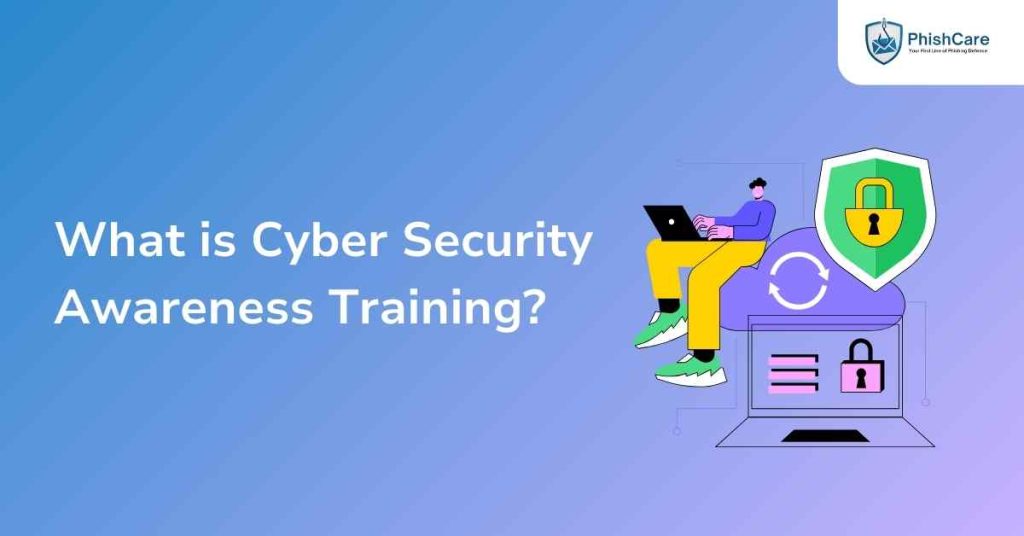The importance of cybersecurity is more prevalent than ever. As technology advances, the sophistication of cyber threats continues to evolve.
Organizations, educational institutions, and individuals must be aware of these risks. One of the most effective ways to combat these threats is through cyber security awareness training. This article explores cybersecurity awareness training, its importance, challenges, and best practices for implementation..
Understanding Cyber Security Awareness Training
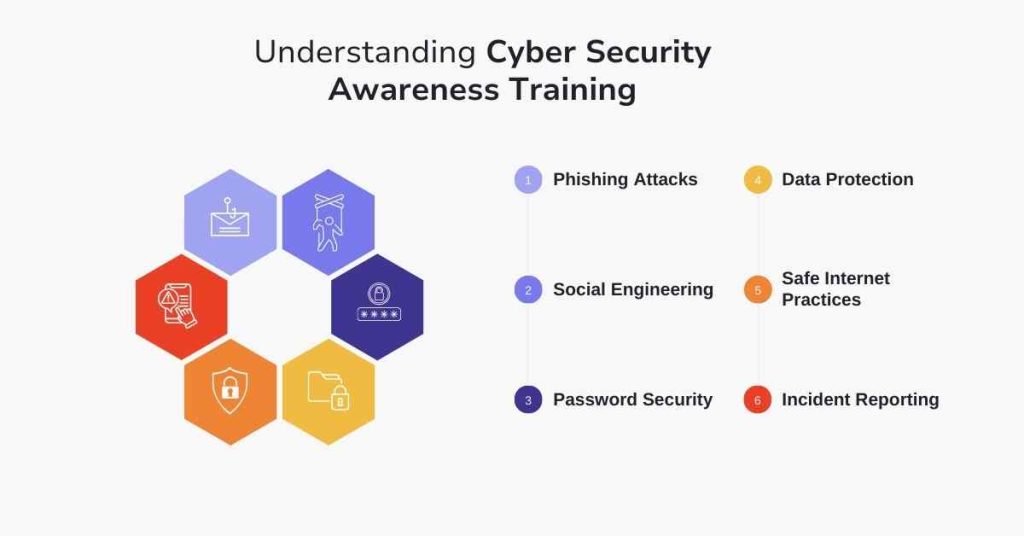
Cybersecurity awareness training is an educational process designed to inform individuals about cyber threats and how to protect themselves from them. It covers a variety of topics, including:
1. Phishing Attacks
Training teaches individuals how to recognize phishing emails, which often lure users into revealing personal information or downloading malicious software.
2. Social Engineering
This involves manipulative tactics used by cybercriminals to gain sensitive information. Training helps individuals identify these tactics and respond appropriately.
3. Password Security
Strong password management is crucial for protecting accounts. Training emphasizes the creation of strong, unique passwords and the use of password managers.
4. Data Protection
Understanding the importance of safeguarding confidential data, including personal information and company secrets, is a key focus.
5. Safe Internet Practices
This includes guidance on safe browsing habits, recognizing secure websites, and avoiding risky downloads.
6. Incident Reporting
Employees are trained on how to report suspicious activities or security breaches to the appropriate channel within the organization.
How Does PhishCare Conduct Cyber Security Awareness Training?
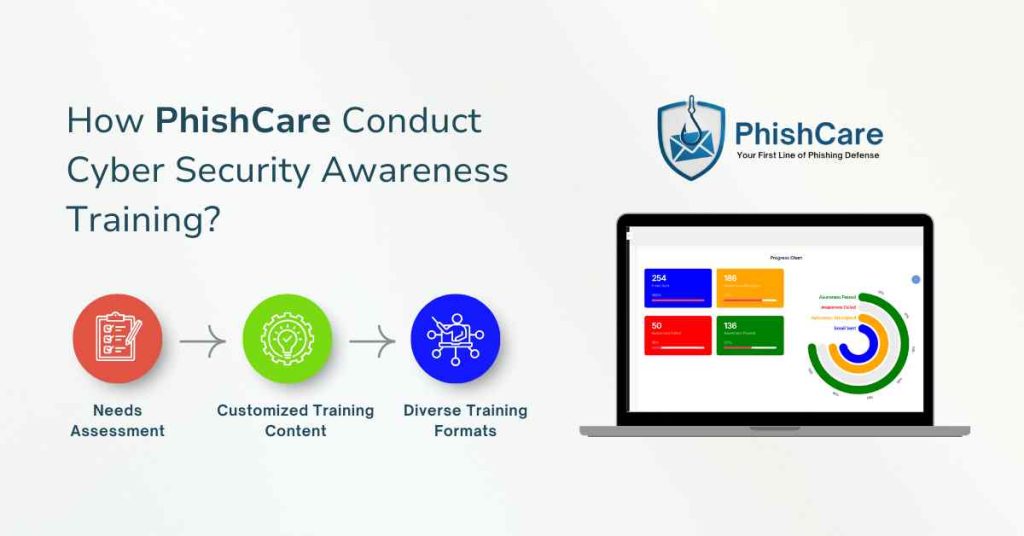
The approach PhishCare takes to conduct its cyber security awareness training is designed to educate employees about cyber threats effectively and foster a culture of security within organizations. Here’s an overview of how CyberSapiens typically conducts its cyber security awareness training:
1. Needs Assessment
Before launching a training program, PhishCare often conducts a thorough needs assessment. This involves:
- Analyzing Current Security Posture: Understanding the current cyber security landscape of the organization, including existing vulnerabilities and past incidents.
- Identifying Audience: Tailoring the training content to the specific needs of different employee groups based on their roles and responsibilities.
- Setting Goals: Defining clear objectives for what the training is intended to achieve, such as reducing phishing incidents or compliance with regulations.
Why PhishCare is the Best Phishing Simulation Tool for Cyber Security Awareness Training!

- Customizable Templates
- Awareness Module
- Assessment Test
- Comprehensive Tracking
- Graphical Dashboard Access
- Campaign Report
- Custom Domain Integration
2. Customized Training Content
PhishCare develops tailored training content that is engaging and relevant. This includes:
- Interactive Modules: Interactive modules utilize multimedia elements, such as videos, animations, and scenarios, to explain complex concepts.
- Real-World Scenarios: Incorporating case studies and examples of actual cyber incidents to make the training relatable and practical.
- Gamified Learning: Implementing game-like elements to encourage participation and make learning enjoyable.
3. Diverse Training Formats
To accommodate different learning styles and schedules, PhishCare offers training in various formats:
- Online Courses: Self-paced modular training accessible anytime and anywhere, allowing flexibility for employees.
- In-Person Workshops: Interactive sessions led by trainers, providing opportunities for hands-on practice and group discussions.
- Webinars: Live online sessions that allow for real-time engagement and Q&A opportunities.
The Importance of Cyber Security Awareness Training
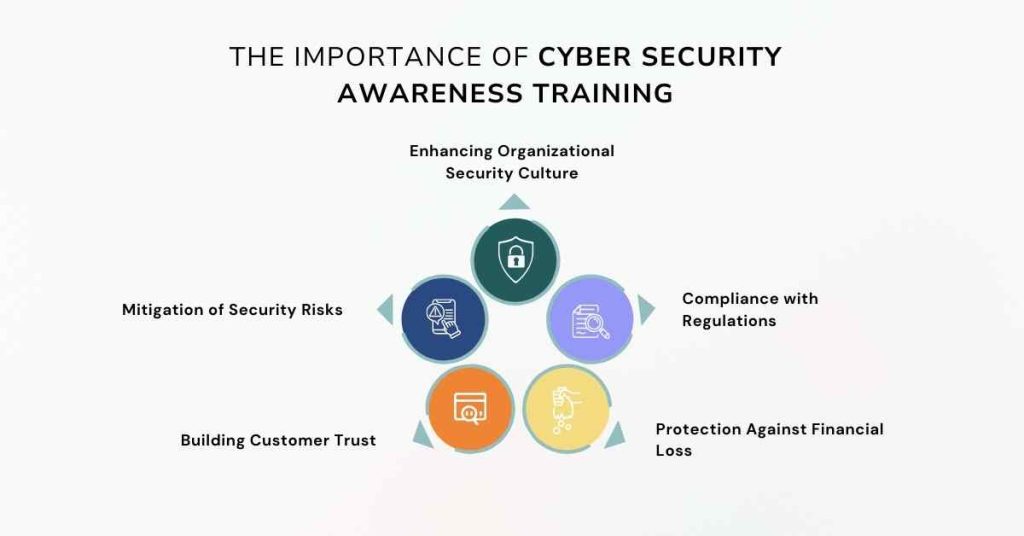
1. Mitigation of Security Risks
Human error is often the weakest link in cybersecurity. According to a study by IBM, up to 95% of cybersecurity breaches occur due to human mistakes. By providing comprehensive training, organizations can significantly reduce risks associated with user behaviour. Employees who are aware of security protocols are less likely to engage in risky activities, such as clicking on malicious links or ignoring security updates.
2. Enhancing Organizational Security Culture
Implementing cybersecurity awareness training fosters a culture of security within an organization. Employees become more vigilant and proactive about security issues, leading to better overall security posture. A strong security culture fosters accountability, encouraging employees to take ownership of their responsibilities in protecting sensitive information.
3. Compliance with Regulations
Many industries are subject to regulatory requirements concerning data protection. For instance, healthcare organizations must comply with HIPAA, while companies in the finance sector must adhere to PCI-DSS requirements. Cybersecurity awareness training helps organizations meet these legal obligations by ensuring that employees are informed about their responsibilities in safeguarding sensitive data.
4. Protection Against Financial Loss
Cyberattacks can be financially devastating. The cost of data breaches can reach millions of dollars when accounting for investigation, recovery, legal fees, and loss of customer trust. By investing in cybersecurity awareness training, organizations can potentially save significant amounts in costs associated with cyber incidents.
5. Building Customer Trust
In an era where data breaches make headlines, customers are increasingly concerned about the safety of their personal information. Organizations that prioritize cybersecurity and invest in awareness training demonstrate a commitment to protecting their customers’ data. This can enhance customer trust and loyalty, as clients feel safer when engaging with businesses that take security seriously.
Challenges in Cyber Security Awareness Training
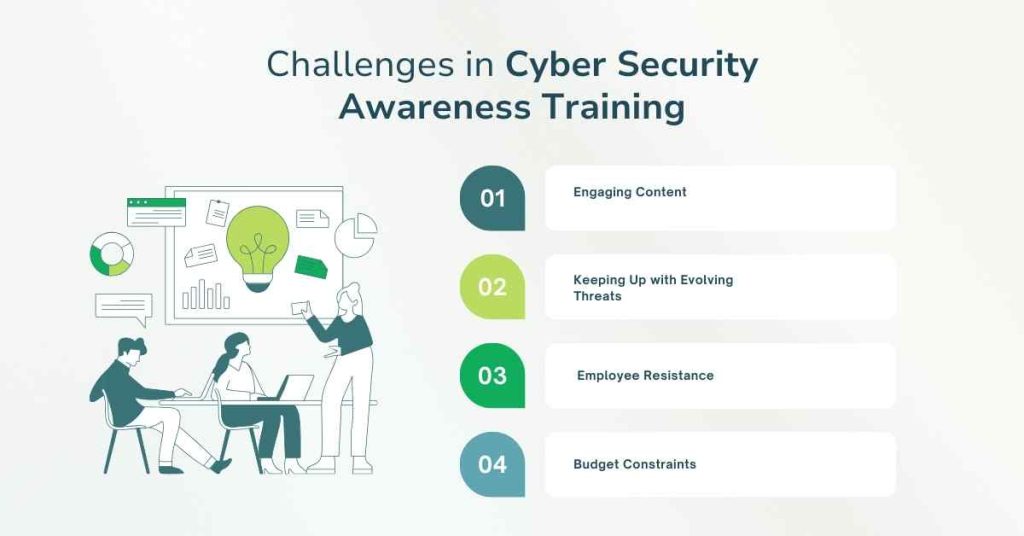
1. Engaging Content
One of the biggest challenges in cybersecurity awareness training is delivering engaging content. Traditional training methods, such as lengthy presentations, can lead to low retention rates. Organizations must find innovative and interactive ways to deliver training, such as gamification, real-life scenarios, and multimedia presentations.
2. Keeping Up with Evolving Threats
The cyber landscape is constantly changing, and new threats emerge frequently. Training programs must be regularly updated to address the latest risks and emerging trends. Organizations must stay informed about the current cybersecurity threats and adjust their training programs accordingly.
3. Employee Resistance
Some employees may view training as a burden, particularly if it disrupts their workflow. Overcoming this resistance requires effective communication about the importance of training and how it benefits both the individual and the organization. Building a culture where cybersecurity awareness is valued can help mitigate resistance.
4. Budget Constraints
Investing in comprehensive cybersecurity awareness training can require a significant budget, which can be a barrier for some organizations, especially smaller ones. However, cost-effective training solutions, such as online modules and open educational resources, can help bridge this gap.
Best Practices for Implementing Cybersecurity Awareness Training
1. Tailor Training Programs
One-size-fits-all training programs are often ineffective. Tailoring training to the specific needs and challenges of the organization can result in better engagement and retention. Different departments may face unique risks, so customizing training content for specific roles can enhance relevance.
2. Use Interactive and Engaging Methods
To maintain interest and improve retention, organizations should use interactive methods, such as quizzes, hands-on exercises, and scenarios that allow employees to practice their skills in real-time. For instance, role-playing exercises can help in understanding social engineering.
3. Provide Continuous Training
Cybersecurity awareness should not be a one-time event. Continuous training, whether through annual refresher courses or regular updates on new threats, keeps employees informed and engaged. Micro-learning formats, where brief, focused training sessions are offered regularly, can be particularly effective.
4. Foster a Supportive Environment
Creating a culture of openness encourages employees to speak up about concerns or report incidents without fear of retribution. Leadership should promote the importance of security and openly discuss cybersecurity initiatives within the organization.
Conclusion
Cybersecurity awareness training is an essential strategy for helping individuals and organizations combat the growing threat of cybercrime. By equipping employees with the knowledge to identify and mitigate potential vulnerabilities, organizations can foster a culture of security, reduce risks, and protect sensitive data.
While challenges exist in implementing effective training, following best practices can lead to successful programs. As cyber threats continue to evolve, ongoing education and awareness will be critical in maintaining robust cybersecurity measures and safeguarding valuable information in this digital age.
FAQs: What is Cyber Security Awareness Training?
1. Why is cybersecurity awareness training important?
Ans:This training is vital because it helps mitigate the risk of cyberattacks, which often result from human error. By educating employees about common threats and safe practices, organizations can enhance their security posture, comply with regulations, and protect sensitive data.
2. Who should undergo cybersecurity awareness training?
Ans:All employees, regardless of their role or level of technology use, should participate in cybersecurity awareness training. Since cyber threats can impact anyone, it’s crucial for every individual within an organization to be knowledgeable about security practices.
3. What topics are typically covered in cybersecurity awareness training?
Ans:Training programs usually include topics such as recognizing phishing attacks, understanding social engineering, managing passwords effectively, protecting sensitive data, safe browsing practices, and the protocols for reporting security incidents.
4. How often should cybersecurity awareness training be conducted?
Ans:It’s recommended to provide cybersecurity awareness training at least annually. However, ongoing training or refresher courses every few months can help reinforce knowledge and keep employees updated on the latest threats and best practices.
5. What are some effective methods for delivering cybersecurity awareness training?
Ans:Effective methods include interactive sessions, online training modules, gamified learning, real-life scenario simulations, and hands-on workshops. Engaging content is more likely to capture employees’ attention and enhance retention.
6. How do organizations measure the effectiveness of cybersecurity awareness training?
Ans:Organizations can measure effectiveness through various methods, including pre- and post-training assessments, simulated phishing tests, tracking incident reports, and soliciting feedback from participants to identify areas for improvement.
7. What challenges do organizations face when implementing cybersecurity awareness training?
Ans:Some common challenges include employee disengagement, rapidly evolving cyber threats, difficulty in measuring training effectiveness, resistance to mandatory training, and budget constraints.
8. Can small businesses benefit from cybersecurity awareness training?
Ans:Absolutely! Small businesses are often targeted by cybercriminals, so investing in cybersecurity awareness training can significantly reduce their risk and protect valuable data. Training helps create a culture of security among staff, making them more vigilant against potential threats.
9. What should organizations look for when choosing a cybersecurity awareness training program?
Ans: Organizations should seek training programs that are engaging, relevant to their specific needs, adaptable to new threats, and comprehensive in coverage. They should also consider the program’s ability to provide measurable outcomes and support ongoing education efforts.

